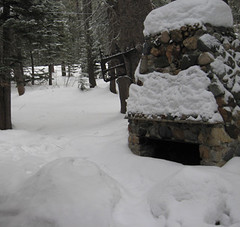Stranded
I'm happily working on the spindle bag:

It is important that the yarns for the knots are sized correctly so that the design is squared. I did a bit of a sampler first, both to check the size and also the color of the yarns:

The pile yarn is three strands held together, both for yarn density and to give the colors depth and variation. As luck would have it, though, the "squares" in the sampler are not square: they are 5 knots wide by 5 rows high, and too truncated to be called squares. I also wanted to shift some of the colors.
The pile yarns I am using are handspun mohair. I could easily add another strand, so in the final bag above, the pile yarns are all four strands. I also shifted some of the colors: the red got a bright red strand, and the gold got another bright gold strand.
I was lucky to be taught knotted pile by a man who used Paternayan yarns for his rugs: it is a rug yarn, spun worsted of luster wool, composed of three two-ply strands. It comes in a multitude of colors, and because of the available palette and strand construction, it is used by rug restorers to match for both grist and color in restoring Navajo and Oriental carpets.
Since I spin my own yarns, I followed this model: worsted-spun fine two-ply, stranded up depending on color and grist needed. For a while I tried using a single strand spun to the right size to square the pattern. But if the pattern did not square, or if the color was slightly off and needed to be shifted, adding another strand was not possible: the yarn was already fat. So I went back to the stranded model, which is more flexible.
I have been a weaver for quite a while now, and have learned that the materials you choose determine the quality of the final product. Cheap textiles, or textiles done for sale, are often woven of heavier yarns: it is faster to spin and weave up. But the best fabrics are made of the finest yarns: the hand is more supple, the fabric drapes and is manageable. The best carpets are also made of the finest yarns: smooth, lustrous and close-tied. It simply makes sense: if you were making a superlative fabric, would you use fat yarns? I wouldn't either.
This last photo is for Eileen, Sue and Lindsey:

S'mores anyone? :)

It is important that the yarns for the knots are sized correctly so that the design is squared. I did a bit of a sampler first, both to check the size and also the color of the yarns:

The pile yarn is three strands held together, both for yarn density and to give the colors depth and variation. As luck would have it, though, the "squares" in the sampler are not square: they are 5 knots wide by 5 rows high, and too truncated to be called squares. I also wanted to shift some of the colors.
The pile yarns I am using are handspun mohair. I could easily add another strand, so in the final bag above, the pile yarns are all four strands. I also shifted some of the colors: the red got a bright red strand, and the gold got another bright gold strand.
I was lucky to be taught knotted pile by a man who used Paternayan yarns for his rugs: it is a rug yarn, spun worsted of luster wool, composed of three two-ply strands. It comes in a multitude of colors, and because of the available palette and strand construction, it is used by rug restorers to match for both grist and color in restoring Navajo and Oriental carpets.
Since I spin my own yarns, I followed this model: worsted-spun fine two-ply, stranded up depending on color and grist needed. For a while I tried using a single strand spun to the right size to square the pattern. But if the pattern did not square, or if the color was slightly off and needed to be shifted, adding another strand was not possible: the yarn was already fat. So I went back to the stranded model, which is more flexible.
I have been a weaver for quite a while now, and have learned that the materials you choose determine the quality of the final product. Cheap textiles, or textiles done for sale, are often woven of heavier yarns: it is faster to spin and weave up. But the best fabrics are made of the finest yarns: the hand is more supple, the fabric drapes and is manageable. The best carpets are also made of the finest yarns: smooth, lustrous and close-tied. It simply makes sense: if you were making a superlative fabric, would you use fat yarns? I wouldn't either.
This last photo is for Eileen, Sue and Lindsey:

S'mores anyone? :)

5 Comments:
May I ask if this is done on your cricket and if so what the epi is? I can't wait to see how it comes out:>.
I was just wondering about weaving up my stash of Paternayan...
Perhaps by November, perhaps in Vermont...
Nice to see the pattern still inspiring some 'what if's...!'
I got your book and love it-you did a great job of sharing your vision of weaving. Thanks.
Interesting! It makes lots of sense to have an adjustable yarn.
I just received your book last night, as a belated (and requested) Christmas present. What a delight! My head is buzzing with ideas.
Gee, I have always wondered about Paternayan yarn. Any idea what breed is used? I have heard varied opinions but always wanted to know for myself. Care to make an educated guess?
Post a Comment
<< Home